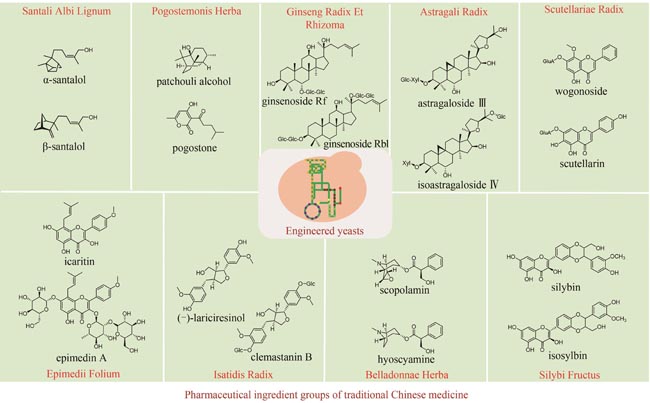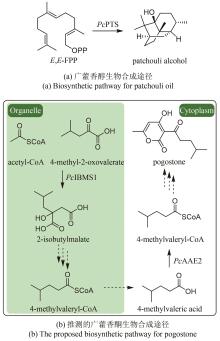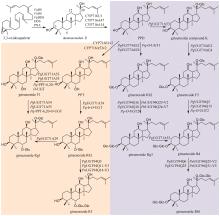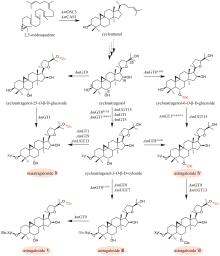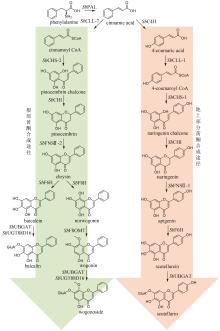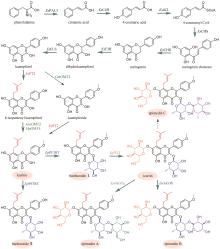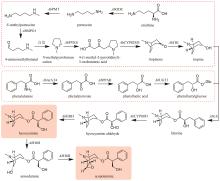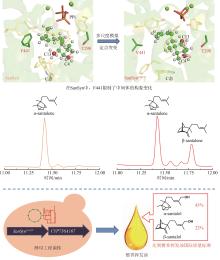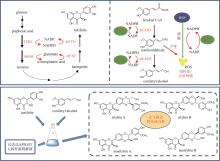|
||
|
Advances in synthetic biology for producing potent pharmaceutical ingredients of traditional Chinese medicine
Synthetic Biology Journal
2024, 5 (3):
631-657.
DOI: 10.12211/2096-8280.2023-082
Traditional Chinese medicine (TCM) is a treasure of Chinese civilization and also a good mine for drug development in China. Many TCM components come from rare biological species including plants, animals, and insects, making the preparation of these TCM pharmaceutical substances at large scales a bottleneck that substantially impedes TCM-based drug development. However, the rapid development of synthetic biology has provided a strategy for addressing this challenge. At present, significant progress has been made in the bio-production of individual TCM components, but the efficacy of TCM is mainly due to the synergistic effect of those ingredients, which are termed as pharmaceutical ingredient groups. Reports on constructing the bio-production platform of pharmaceutical ingredient groups are limited. Herein, we summarize research progress in the biogenic mechanism of important TCM pharmaceutical ingredient groups, such as volatile oils, saponins, flavonoids, lignans and alkaloids. Some individual components of pharmaceutical ingredient groups (e.g. ginsenosides) are synthesized by multiple branching pathways, which can be produced and formatted thereafter. On the other hand, some pharmaceutical ingredients such as sandalwood oil can be synthesized through single pathways/enzymatic reactions by engineering the key enzymes to optimize their ratio. We comment the strategy of combining enzyme engineering and metabolic engineering to optimize both the production of pharmaceutical ingredient groups and their ratio. At the end, we outline the prospect of synthetic biology research for producing pharmaceutical ingredient groups, including: (1) complete clarification of the biogenic mechanism of more complex pharmaceutical ingredient groups, (2) development of novel metabolic engineering approaches for breaking through homogenization of methodology, and (3) optimization of the catalytic characteristics of key synthetic enzymes by combining rational design and directed evolution.

Fig. 8
Biosynthetic pathway for lignans in I. indigotica
Extracts from the Article
板蓝根是菘蓝(Isatis indigotica Fortune)的干燥根,具有清热解毒、凉血利咽的功效,临床上常用于治疗流行性感冒和病毒性感染等[102]。研究表明,板蓝根抗病毒的药效成分为木脂素类化合物,主要包括:落叶松脂醇(lariciresinol)、开环异落叶松脂醇(secoisolariciresinol)、落叶松脂醇苷以及直铁线莲宁B(clemastanin B)等。目前,已经基本解析了这些成分的生物合成途径(图8)。与典型黄酮生物合成途径的前两步相同,苯丙氨酸在苯丙氨酸解氨酶(IiPAL1和IiPAL2)和肉桂酸-4-羟化酶(IiC4H)催化下生成4-香豆酸(图8)[103]。在菘蓝中,4-香豆酸可经过两条路径生成松柏醛。第一条路径:在4-香豆酰辅酶A连接酶(Ii4CL2)催化下,得到4-香豆酰辅酶A;4-香豆酰辅酶A在羟基肉桂酰转移酶(IiHCT)和香豆酸-3-羟化酶(IiC3H)催化下,经中间体4-香豆酰莽草酸酯,生成咖啡酰辅酶A(caffeoyl CoA);咖啡酰辅酶A氧甲基转移酶(IiCCoAOMT)和肉桂酰辅酶A还原酶(IiCCR)顺序催化羟基甲基化和还原反应,生成松柏醛(coniferaldehyde)(图8)[103]。在第二条途径中,首先IiC3H羟基化4-香豆酸,得到咖啡酸;然后在Ii4CL2/3以及IiCCoAOMT的催化下,与辅酶A连接并甲基化得到阿魏酰辅酶A;IiCCR催化阿魏酰辅酶A的还原,生成松柏醛(图8)[103]。除以上两条途径外,在大多数植物中还存在第三条合成松柏醛的途径:首先在咖啡酸氧甲基转移酶(COMT)的催化下,咖啡酸转化为阿魏酸,进一步在4CL的催化下连接辅酶A生成阿魏酰辅酶A;最后CCR催化阿魏酰辅酶A还原,生成松柏醛[103-104]。由于目前未从菘蓝中发现COMT,因此是否存在这条路径尚不确定。松柏醛经肉桂醇脱氢酶(IiCAD)氧化,生成木脂素的关键前体化合物松柏醇(coniferyl alcohol)[103]。2分子松柏醇通过自由基偶联反应生成第一个具有木脂素骨架的化合物松脂醇(pinoresinol),这步反应被认为由过氧化物酶或漆酶催化完成,dirigent蛋白可保证反应的立体选择性[105]。陈瑞兵等[106]从菘蓝转录组中鉴定了19条dirigent蛋白编码基因,在菘蓝毛状根中过表达这些基因,发现IiDIR1和IiDIR2的表达选择性地促进(-)-松脂醇合成,证明了这两个酶在立体选择性控制方面的重要作用。松脂醇/落叶松脂醇还原酶(IiPLR1)连续催化松脂醇的C7-O-C9′和C7′-O-C9醚键的开裂,生成落叶松脂醇(lariciresinol)和开环异落叶松脂醇(secoisolariciresinol)(图8)。IiPLR1和AtPrR1(拟南芥的松脂醇还原酶)均为首尾连接的同源二聚体[107]。通过两种酶结构的比较分析,揭示了IiPLR1的催化机制[107]。IiPLR1催化松脂醇向开环异落叶松脂醇转化的过程包括:松脂醇的结合、落叶松脂醇的生成、落叶松脂醇的释放、落叶松脂醇的结合以及开环异落叶松脂醇的生成。即落叶松脂醇生成后并未立刻继续开环生成开环异落叶松脂醇,而是经历了释放-再结合的过程。相对于IiPLR1,AtPrR1的底物结合口袋空间更小并且底物的进入被更严格地控制,因此阻碍了释放出的落叶松脂醇再次进入活性口袋,不能进一步开环生成开环异落叶松脂醇。两种酶中的β4 loop在底物/产物以及辅因子NADPH/NADP+的结合与释放中发挥了关键作用。具体来讲,β4 loop负责招募NADPH,并且在底物结合后覆盖底物结合槽。β4 loop上的98位氨基酸残基显著影响β4 loop的摆动,从而与底物的选择性密切相关。当把AtPrR1中体积较大的N98突变为体积较小的S98(与IiPLR1相同)后,AtPrR1N98S可产生开环异落叶松脂醇。目前,从菘蓝中表征了四个与木脂素苷生物合成相关的糖基转移酶。其中,IiUGT1是糖基化松脂醇的主要糖基转移酶,可产生松脂醇-4-O-葡萄糖苷(pinoresinol-4-O-glucoside)和松脂醇-4,4′-O-二葡萄糖苷(pinoresinol-4,4′-O-diglucoside)(图8)[108];IiUGT71B5a和IiUGT71B5b同样具有糖基化松脂醇的功能,前者产生松脂醇-4-O-葡萄糖苷和松脂醇-4,4′-O-二葡萄糖苷,后者仅能产生松脂醇-4-O-葡萄糖苷(图8)[109];IiUGT4负责落叶松脂醇的糖基化,可产生落叶松脂醇-4-O-葡萄糖苷(lariciresinol-4-O-glucoside)、落叶松脂醇-4′-O-葡萄糖苷(lariciresinol-4′-O-glucoside)和直铁线莲宁B[108](图8)。
Other Images/Table from this Article
|
